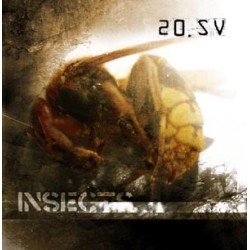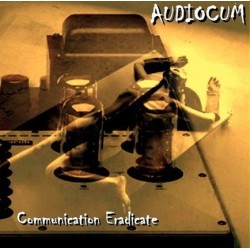|
Inspired by the work of such artists as Aube and William Basinski, Bionulor again rakes the past, looking like an alchemist for the most appropriate material for their work. "Sacred Mushroom Chant" is a record created solely on the basis of treatment of the human voice without additional sounds or instruments.
Cover art by Monika Machnik, mastered by Peter Andersson. Comes in 4-panel digipack. You will be really impressed when you realize that those tracks were crafted only with scraps of samples. |
|
Tracklist: 01. SCRD. MSHRM. CHNT. 02. NHN-B. 03. NL. 04. DCHMP. 05. NIC NIE JEST PRAWDZIWE |
|
Reviews in magazines and press: When I reviewed Bionulor’s debut release a bit less than two years ago, I complimented his conceptual use of "sound recycling," but felt the compositions lacked focus and structure. On this sophomore release, Sebastian Banaszczyk has definitely stepped up his game, and the results are quite satisfying. Thematically linked by using the human voice as a sound source, each of the five pieces here pull that element from widely varying contexts and then use it completely differently. For example, "Nhn-B." decimates a traditional Japanese song into what at first has a sparse, spacey vibe to it, but soon degenerates into a tortured chorus screaming through reverb hell, shattering the open calm. "NL.," built upon Neal Armstrong’s famous recording from walking on the moon, initially allows its pedigree to come forth, with clipped voices and radio static overtly opening the piece from near silence. After these initially violent outbursts, the voices disappear, leaving only their minute traces to be heard, which Banaszczyk shapes into dramatic, almost prog rock swells that expand for infinity, much like the vastness Armstrong was witnessing as he made his statement. Based upon an interview with Marcel Duchamp, "Dchmp." allows its source material to be heard at first, but is deconstructed into a high pitched squeal and little squirty outbursts of noise that come and go with reckless abandon. While the outro develops into more conventional “noise” territory, it is the most idiosyncratic piece, and also the most memorable, with its odd organic blasts of noise sounding like no one else. "Nic Nie Jest Prawdziwe" features Banaszczyk himself, reading the infamous "Nothing is true" quote from Hassan-i Sabbah. Taking a more conventional approach of allowing his looped voice to be slowly disintegrated by effects, it first is mired in the expected echoes, reverbs, and delays, but is then disemboweled into fragments of phonemes, cut into stuttering beats or pulled apart into pure static, leaving nothing of its original nature to be heard. The only misstep is the long opening "Scrd. Mshrm. Chnt.," because, throughout its nearly 22 minute duration, there is simply too much of a collage feel to it, and the piece never feels like it truly gets its footing. It is a compelling collection of percussive clicks, varying textures and alternating loud and quiet dynamics, but it lacks the clear compositional structure of the other pieces. Bionulor has demonstrated some significant growth in both his style and compositions since his first album, and he is doing well carving out his own niche in a relatively crowded genre. The project Bionulor began in 2006, a one-man experimental/ambient project founded by Sebastian Banaszczyk- he bases all the projects recordings on “recycled sound”. Mainly he builds his musical foundation on one sample (or fragment) and then processes the snippet adding or expanding the sound it was built on. Sacred Mushroom Chant is no different. On the five pieces presented here sounds are based on shamanic chants, a Japanese traditional song, Neil Armstrong, Marcel Duchamp and Sebastian Banaszczyk himself. Each of the five pieces thrusts the listener into a strange, cosmic setting. Sometimes the only familiarity is the spoken word subject Banaszczyk has used. On the whole each piece is a juxtaposition of organic and man-made. On “Scrd.Mshrm.Chnt.” intermittent beeps and swirls collide into a cocoon of cosmic electronic sounds, yet there is a human (or animalistic) feeling that we are in the presence of a living breathing being. Both “NHN-B” and “NL” seem to be (at least through my ears) are very fine tribute to Kubricks 2001. This is in contrast to “DCHMP”; where we get the feeling of surfing on a radio dial, barely tuning into different frequencies, yet the repetitive spoken sample lulls us into a meditative state. The last piece “Nic Nie Jest Prawdziwe” (the English translation to this Polish phrase is “Nothing is True (Genuine). Here Banaszczyk loops the phrase over and over adding reverbed sound and ambient white noise. It almost borders on the industrial; yet again the repetitiveness of it becomes hypnotic. All in all in this is a very interesting work from the Bionulor project. It will be fascinating to see where and how he expands on his basis of his sonic operations. Even more so it will be compelling to see if he will collaborate with other artists to build on his themes. (Victorya Kaufholz)
In Vital Weekly 795 I was first introduced to the music of Sebastian Banszczyk, also known as Bionular. He calls his music '100% sound recycling', but I guess all music is recycling? If you buy a guitar in order to play the guitar, you are recycling the guitar, I'd say. But Bionulor perhaps means something else, to use sounds that are not musical in a musical context. Like Aube before him, he limits himself to one sound source here, in this case the human voice. In the first three pieces this is not easy to spot, but the 'NL' opens with Nasa flight control, which perhaps ruins it a bit for me. His first release found him along the lines of Stephan Mathieu or Fennesz, I think Bionulor expanded his sound here. As said I liked it better when things were a bit more abstract, and more to guess. The website reveals some sources, such an archival record of a shamanic chant associated with the ceremony of taking hallucinogenic mushrooms, Japanese songs from old vinyl records and Marcel Duchamp. In the first two pieces Bionulor stays close to his previous warm ambient glitched sound, be it in a somewhat more rhythmic mood than before. Hard to recognize voices in here, but the pieces sound quite nice. As said the Nasa thing ruins a bit the moody character of the release, and perhaps also gives away a bit too much of the sound source, but throughout this disc is a step forward for Bionulor, leaving the earlier influences behind and going into new directions, which aren't his own, not just yet, but its certainly a well made album and one from an upward curve. (FdW) We last heard from Polish musician Bionulor in 2009 with a very credible CDR whose cover bore an alchemical theme. On his second release Sacred Mushroom Chant (Wrotycz WRT 011), Sebastian Banasczyk once again confines himself to the discipline of working with one sampled source at a time. All five cuts here are sourced from voice and spoken word records, including shamanic chants, the US moonwalk, and an interview with Marcel Duchamp; Bionulor’s selection of cultural fragments is saying something about the furthest reaches of the human mind and our endeavours, and among other themes there is certainly a strong hallucinatory undercurrent to this release. To listen is to succumb freely to an opium torpor. On a technical level, it is most impressive how he has managed to find bass notes, musical tones, rhythms and patterns from these voice samples, and carefully assembled his jigsaws to create very imaginative ambient and electronic musical shapes. The innovations in his techniques allow him to bypass the overused and over-familiar sounds that blight many other records of modern electronic drone. A good one. Those who upon seeing the title approach the sophomore release from Bionulor with an expectation of psychedelic influence, whether overt or subtle, will be disappointed. This is sound installation fodder from start to finish. Though on paper, Sebastian Banaszczyk's decision to work exclusively with samples of the human voice (Tibetan Monks, a Japanese folk tune, Neil Armstong on the moon, Marcel Duchamp, and the artist himself reciting Hassan i Sabah's 'Nothing is true' quote) is intriguing, in practice it is actually not so great. When the album is treated like something other than an album - that is, as some sort of sound art or installation - it can be a interesting collection, especially when production techniques like the speaker-panning displayed on "DCHMP." are taken into consideration. However, Banaszczyk's style is too reliant on short clicks and high-pitched drones for it to be enjoyable in a straight-through, music record fashion. As that's the way most of us are accustomed to taking our aural stimuli, Sacred Mushroom Chant suffers. (Lee Stablein) |

![Bionulor - Sacred Mushroom Chant [CD]](https://steelwork.fr/746-large_default/bionulor-sacred-mushroom-chant-cd-.jpg)
![Bionulor - Sacred Mushroom Chant [CD]](https://steelwork.fr/746-small_default/bionulor-sacred-mushroom-chant-cd-.jpg)





